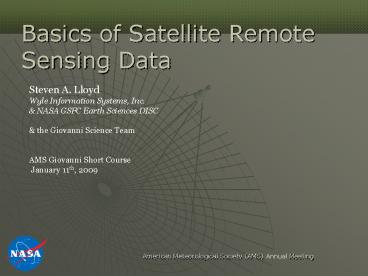Basics of Satellite Remote PowerPoint PPT Presentation
1 / 22
Title: Basics of Satellite Remote
1
Basics of Satellite Remote Sensing Data
Steven A. Lloyd Wyle Information Systems, Inc.
NASA GSFC Earth Sciences DISC the Giovanni
Science Team AMS Giovanni Short Course
January 11th, 2009
2
Why do we need all this data?
? NASA GES DISC and Giovanni ?
Source US Climate Change Science Program (CCSP)
3
Science Paradigm
??
Not only how to use the data, but how not to
misuse it
4
Earth-Observing Satellites
North Pole (hidden)
Direction of Earths Rotation
Plane of Equator
NASAs Big Blue Marble Photograph taken from
Apollo 17 7 December 1972
South Pole
4
5
Earth-Observing Satellites
Geostationary or Geosynchronous Earth Orbit
(GEO) Orbiting at an altitude of 20,000-30,000
km.
Most NOAA and ESA weather satellites are in a
geostationary orbit
The satellite maintains an equatorial orbit above
a given fixed point on the Earths surface, and
rotates around the Earths axis at the same rate
as the planet itself.
5
6
Earth-Observing Satellites
Path of Satellite
Most NASA and ESA atmospheric research satellites
are in a Low Earth Orbit (LEO)
Sun-Synchronous, Near-Polar, Low-Earth Orbit
(LEO)
6
7
Earth-Observing Satellites
Low Earth Orbit (LEO) Orbiting at an altitude of
600-1,000 km.
Path of Satellite
7
8
Earth-Observing Satellites
Low Earth Orbit Orbiting at an altitude of
600-1,000 km.
Path of Satellite
Ascending Orbit The satellite is moving South to
North when that portion of the orbit track
crosses the equator.
8
9
Earth-Observing Satellites
Low Earth Orbit Orbiting at an altitude of
600-1,000 km.
Ascending Orbit The satellite is moving South to
North when that portion of the orbit track
crosses the equator.
Descending Orbit The satellite is moving North
to South when that portion of the orbit track
crosses the equator.
9
10
Earth-Observing Satellites
Low Earth Orbit Orbiting at an altitude of
600-1,000 km.
Ascending Orbit The satellite is moving South to
North when that portion of the orbit track
crosses the equator.
Descending Orbit The satellite is moving North
to South when that portion of the orbit track
crosses the equator.
Ascending vs. descending orbits are like night
and day!
10
11
Earth-Observing Satellites
Low Earth Orbit Orbiting at an altitude of
600-1,000 km.
Ascending Orbit The satellite is moving South to
North when that portion of the orbit track
crosses the equator.
Sun-Synchronous The satellite is always in the
same relative position between the Earth and Sun.
Descending Orbit The satellite is moving North
to South when that portion of the orbit track
crosses the equator.
11
12
Earth-Observing Satellites
Low Earth Orbit Orbiting at an altitude of
600-1,000 km.
Ascending Orbit The satellite is moving South to
North when that portion of the orbit track
crosses the equator.
Period A typical polar, Sun-synchronous LEO
satellite takes about 90 minutes to completely
circle the Earth. This gives it about 16 orbits
per day.
Descending Orbit The satellite is moving North
to South when that portion of the orbit track
crosses the equator.
Sun-Synchronous The satellite is always in the
same relative position between the Earth and Sun.
12
13
Earth-Observing Satellites
Low Earth Orbit Orbiting at an altitude of
600-1,000 km.
Ascending Orbit The satellite is moving South to
North when that portion of the orbit track
crosses the equator.
Equator-Crossing Time The local apparent solar
time when the satellite crosses the
equator. Example Terra has an equator crossing
time of 1030 am, and is called an AM or
morning satellite.
Period A typical polar, Sun-synchronous LEO
satellite takes about 90 minutes to completely
circle the Earth. This gives it about 16
orbits per day.
Descending Orbit The satellite is moving North
to South when that portion of the orbit track
crosses the equator.
Sun-Synchronous The satellite is always in the
same relative position between the Earth and Sun.
13
14
Earth-Observing Satellites
Low Earth Orbit Orbiting at an altitude of
600-1,000 km.
Ascending Orbit The satellite is moving South to
North when that portion of the orbit track
crosses the equator.
Equator-Crossing Time The local apparent solar
time when the satellite crosses the
equator. Example Terra has an equator crossing
time of 1030 am, and is called an AM or
morning satellite.
Period A typical polar, Sun-synchronous LEO
satellite takes about 90 minutes to completely
circle the Earth. This gives it about 16
orbits per day.
Descending Orbit The satellite is moving North
to South when that portion of the orbit track
crosses the equator.
Sun-Synchronous The satellite is always in the
same relative position between the Earth and Sun.
Inclination The
position of the orbital plane relative to the
equator. For near-polar orbits, typically about
97º.
14
15
Satellite Inclination
Low Inclination Orbit (often near 57º-- Space
Shuttle) no polar coverage
High Inclination or Polar Orbit (near
90º) virtually complete global coverage
Equator
Inclination The
position of the orbital plane relative to the
equator. For near-polar orbits, typically about
97º.
15
16
Satellite Viewing Geometry
Nadir
Solar Zenith Angle
Elevation Angle
Zenith
Horizon
16
17
Satellite Viewing Geometry
Direction of Satellite Motion
Push-Broom
Cross-Track Scanning
17
18
Satellite Viewing Geometry
Cross-track scanning results in individual
observations (pixels) of varying size, and can
leave gaps between successive orbits if the scan
angle is not wide enough.
18
19
Nimbus-7
Earth Probe
EOS Aura
Nimbus-7 Total Ozone Mapping Spectrometer
(TOMS)Earth Probe Total Ozone Mapping
Spectrometer (TOMS) Aura Ozone Monitoring
Instrument (OMI)
Global View
South Polar View
North Polar View
29 September 1997
20
Other Useful TOMS/OMI Data Products
29 September 1997
21
TOMS Total Ozone October Monthly Averages
22
2007 Antarctic Ozone Hole
- Orientation
- Size
- Shape
- Collar
- Polar Vortex
- Wind Speed
- Discontinuity
- Polar Blank
26 September 2007

